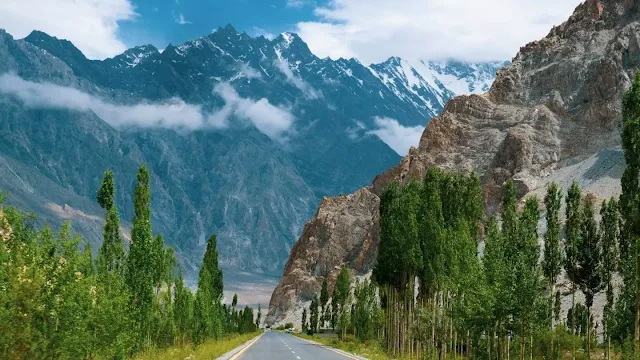All You Need to Know About Hunza Valley Weather and Seasons

Nestled in the heart of the Karakoram mountain range in Pakistan, Hunza Valley is a paradise for nature lovers and adventure seekers. With its breathtaking scenery and rich cultural heritage, this region attracts visitors from all over the world. However, before planning your trip to Hunza Valley, it's important to know about the weather and seasons in this area.
The weather in Hunza Valley can be unpredictable, with extreme temperatures and sudden changes in conditions. From snow-capped peaks to lush green valleys, each season brings its own unique charm to the region. Whether you're planning a trek to the famous Rakaposhi mountain or simply hoping to soak up the local culture, understanding the weather patterns and seasons in Hunza Valley is essential for a successful trip.
In this article, we'll take a closer look at the Hunza Valley weather and seasons, giving you everything you need to know to plan your perfect adventure.
Hunza Valley Weather Overview
The weather in Hunza Valley is unique due to its location in the Karakoram mountain range. The area is characterized by extreme temperatures, high altitude, and sudden changes in weather conditions. The temperature can fluctuate from below freezing to over 40 degrees Celsius in a matter of days, making it important to be prepared for any weather conditions. Additionally, the region experiences heavy snowfall in winter, making some areas inaccessible during this time.Weather Patterns in Hunza Valley
Hunza Valley experiences four distinct seasons, each with its own weather patterns. The summer months (June to August) are generally warm and dry, with temperatures ranging from 20 to 30 degrees Celsius. In contrast, the winter months (December to February) are cold and snowy, with temperatures dropping below freezing. Spring (March to May) and autumn (September to November) are transitional months, with variable weather conditions and occasional rain or snowfall.The weather in Hunza Valley is also influenced by the monsoon season, which typically lasts from July to September. During this time, heavy rain can cause landslides and flooding, making some areas inaccessible. It's important to check the weather forecast and road conditions before traveling to Hunza Valley during the monsoon season.
Best Time to Visit Hunza Valley
The best time to visit Hunza Valley depends on your interests and what you want to see and do. If you're interested in trekking or hiking, the best time to visit is during the summer months (June to August) when the weather is warm and dry. The autumn months (September to November) are also a good time to visit, with cooler temperatures and spectacular autumn colors.If you're interested in winter sports or skiing, the winter months (December to February) are the best time to visit. However, some areas may be inaccessible due to heavy snowfall.
Spring (March to May) is a beautiful time to visit Hunza Valley, with wildflowers in bloom and snow-capped peaks in the background. However, the weather can be unpredictable during this time, with occasional rain and snowfall.
Seasons in Hunza Valley
Summer in Hunza Valley
Summer in Hunza Valley is the peak tourist season, with warm and dry weather and long daylight hours. The temperature can range from 20 to 30 degrees Celsius, making it a great time for outdoor activities like trekking, hiking, and sightseeing. The famous Rakaposhi mountain is also visible during this time, making it a popular destination for trekkers and climbers.
Autumn in Hunza Valley
Autumn in Hunza Valley is a magical time, with cooler temperatures and spectacular autumn colors. The temperature can range from 10 to 20 degrees Celsius, making it a great time for outdoor activities like trekking, hiking, and sightseeing. The changing colors of the leaves provide a stunning backdrop for photography and sightseeing.
Winter in Hunza Valley
Winter in Hunza Valley is a winter wonderland, with snow-capped peaks and frozen lakes. The temperature can drop below freezing, making it a great time for winter sports like skiing and snowboarding. However, some areas may be inaccessible due to heavy snowfall, so it's important to check road conditions before traveling.
Spring in Hunza Valley
Spring in Hunza Valley is a beautiful time, with wildflowers in bloom and snow-capped peaks in the background. The temperature can range from 10 to 20 degrees Celsius, making it a great time for outdoor activities like trekking, hiking, and sightseeing. However, the weather can be unpredictable during this time, with occasional rain and snowfall.
What to Pack for Hunza Valley
When traveling to Hunza Valley, it's important to pack for the weather conditions and activities you plan to do. If you're visiting during the summer months, pack lightweight clothing and comfortable walking shoes. Don't forget to pack sunscreen, a hat, and sunglasses to protect yourself from the sun.If you're visiting during the winter months, pack warm clothing, including a heavy coat, gloves, hat, and boots. You may also want to bring ski or snowboarding gear if you plan to hit the slopes.
No matter what time of year you visit, it's important to pack a first aid kit, insect repellent, and plenty of water and snacks for your outdoor activities.
Conclusion
Hunza Valley is a beautiful destination with something to offer for every season. Whether you're interested in trekking, skiing, or simply soaking up the local culture, understanding the weather patterns and seasons in Hunza Valley is essential for a successful trip.From the warm and dry summer months to the winter wonderland of the cold season, Hunza Valley has something for everyone. So, pack your bags and get ready for an adventure of a lifetime!




